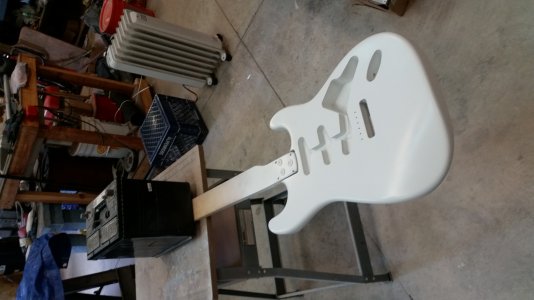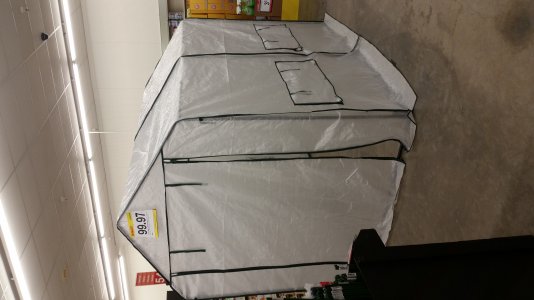Mr. Neutron
Junior Member
- Messages
- 85
Hey, All!
Working on my Warmoth Alder Vintage Strat body. I'm going to try a DupliColor primer & Perfect Match lacquer paint in Olympic White (already had started it before I saw Tonar's thread...... :-\ ). I've got it primed, and now have 3 very light coats of the paint on it. Will put 3 more light coats on tomorrow, I'm thinkin'.
I have few little scattered pieces of dust that managed to settle on the paint. No real surprise, since I am painting in my pole barn/shop.
My questions, for now, are these:
1. Like I said above, I thought I'd like to shoot 3 more light coats tomorrow. Can I lightly scuff the guitar tomorrow before I spray again, with some gray (extra fine, I think?) ScotchBrite? I don't mean that I would "sand" with dry or wet paper; just lightly with ScotchBrite. Or do these acrylic lacquer paints need more time to cure before you do that?
2. Thinking ahead, I plan to let the paint dry for a week, then plan on spraying clearcoat with either Watco or Minwax aerosol clear lacquer.I'm thinking of going with a satin finish, and both companies offer that option. Can I assume that I can lightly scuff the paint after it cures with the ScotchBrite, or does that need to be wet sanded before a satin clearcoat? Does the paint need to cure before I spray clearcoat on it?
3.Has anyone else used a clear lacquer satin finish on their guitar's body? Does it work out okay on painted bodies, particularly white ones?
In EDIT: Changed my mind. It seems most satin finishes tend to get a little glossy over time from simply playing them. So, I may as well just go with gloss to start with.......
Thanks for your patience, you all! Here's a pic of my "Guitar On A Stick".....
Working on my Warmoth Alder Vintage Strat body. I'm going to try a DupliColor primer & Perfect Match lacquer paint in Olympic White (already had started it before I saw Tonar's thread...... :-\ ). I've got it primed, and now have 3 very light coats of the paint on it. Will put 3 more light coats on tomorrow, I'm thinkin'.
I have few little scattered pieces of dust that managed to settle on the paint. No real surprise, since I am painting in my pole barn/shop.
My questions, for now, are these:
1. Like I said above, I thought I'd like to shoot 3 more light coats tomorrow. Can I lightly scuff the guitar tomorrow before I spray again, with some gray (extra fine, I think?) ScotchBrite? I don't mean that I would "sand" with dry or wet paper; just lightly with ScotchBrite. Or do these acrylic lacquer paints need more time to cure before you do that?
2. Thinking ahead, I plan to let the paint dry for a week, then plan on spraying clearcoat with either Watco or Minwax aerosol clear lacquer.
3.
In EDIT: Changed my mind. It seems most satin finishes tend to get a little glossy over time from simply playing them. So, I may as well just go with gloss to start with.......
Thanks for your patience, you all! Here's a pic of my "Guitar On A Stick".....





